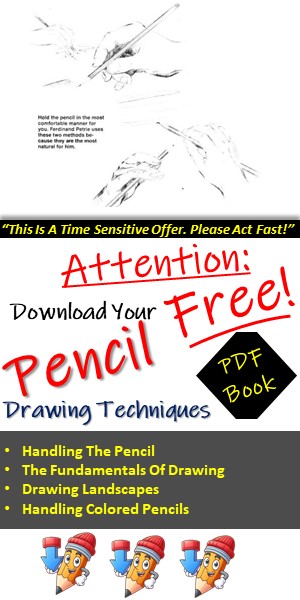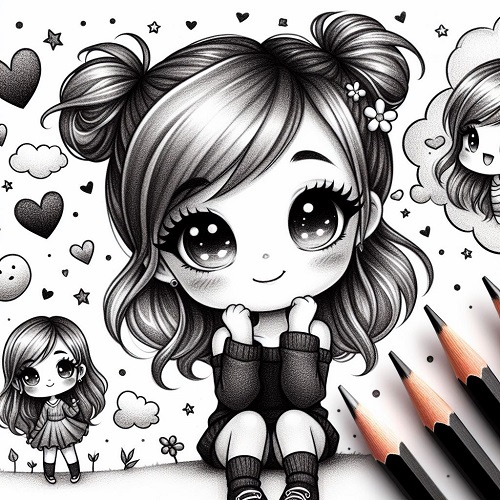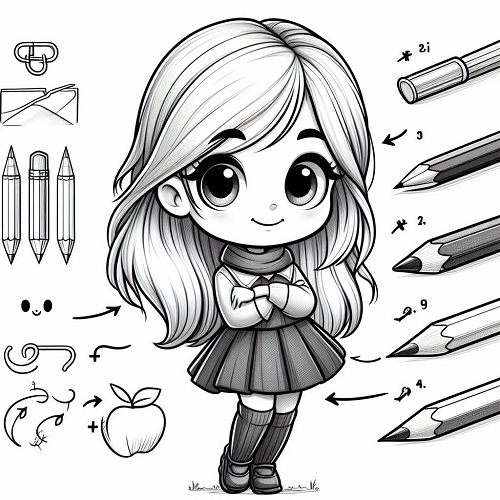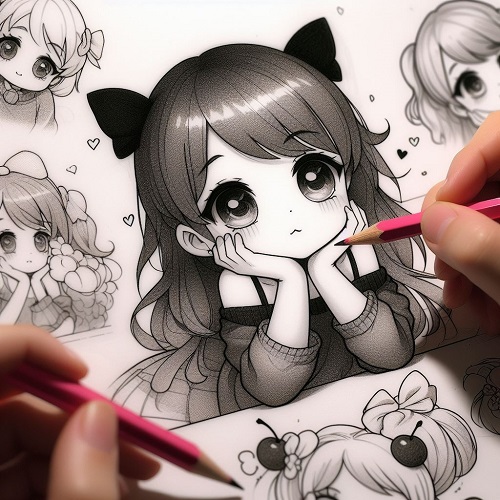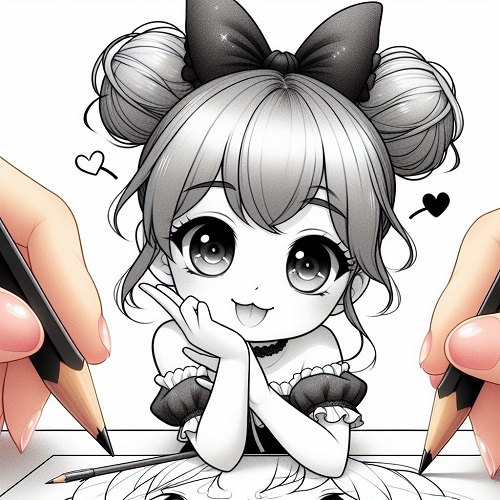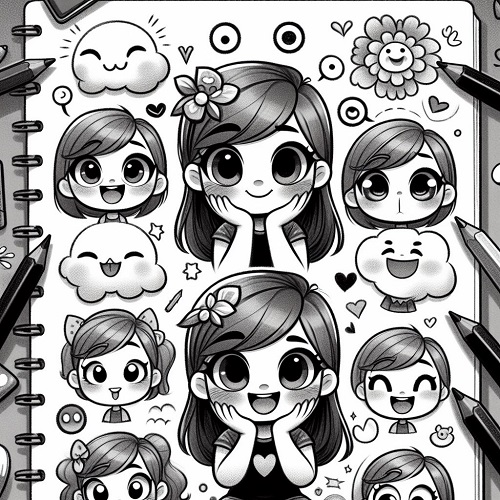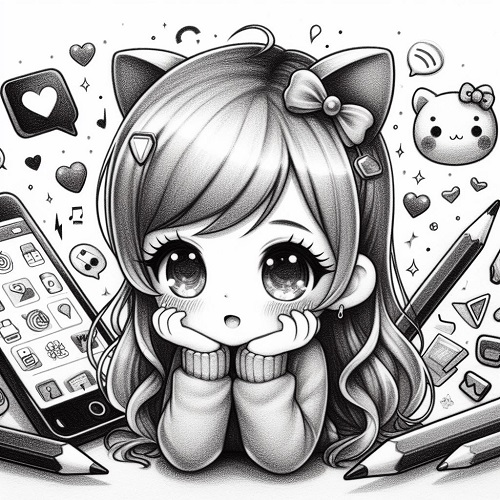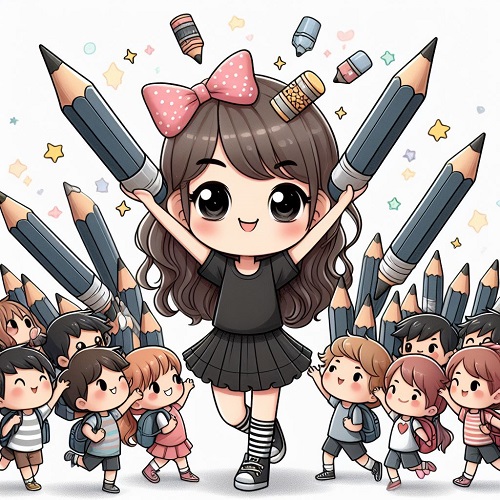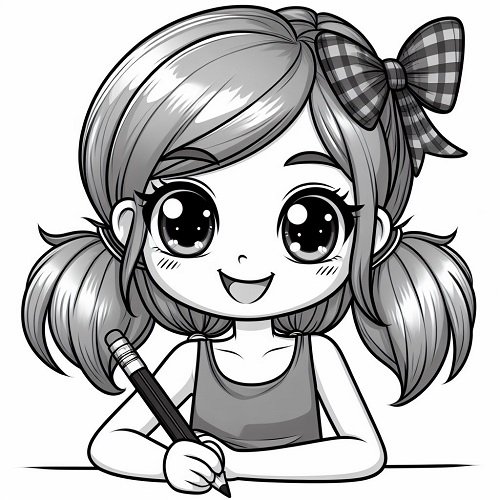Unlocking the Artistry: A Deep Dive into Black Pencil Drawing
Welcome to the captivating realm of black pencil drawing, where strokes on paper transform into timeless pieces of art. In this comprehensive guide, we’ll unravel the nuances of black pencil drawing, from understanding the essential materials to mastering advanced techniques, showcasing inspirational artists, and navigating the intersection of traditional and digital artistry.
I. The Basics of Black Pencil Drawing
A. Essential Drawing Materials
Embark on your black pencil drawing journey by familiarizing yourself with the essential materials. The type of black pencil you choose plays a crucial role in the outcome of your artwork. From the bold darkness of a 6B pencil to the fine lines of an H pencil, each grade offers a unique range of shading possibilities. Pair your pencils with the right paper, exploring different textures and weights. Additionally, discover how accessories like blending stumps, erasers, and sharpeners can enhance the precision and depth of your drawings.
FAQ: What is the difference between an HB and a 2B pencil?
- Answer: The main difference lies in the darkness of the graphite. An HB pencil produces lighter lines compared to a 2B pencil, which is darker and softer. As the number increases, the darkness and softness of the pencil also increase.
B. Understanding Pencil Grades
Delve into the graphite scale to decipher the various pencil grades available. Each grade represents a level of hardness or softness, influencing the intensity of your strokes. Learn to choose the right pencil grade for different effects – from the fine details of a 4H pencil to the rich shading of a 6B pencil. Explore shading and blending techniques that harness the full potential of your chosen pencil grade.
FAQ: Can I use any paper for black pencil drawing?
- Answer: While you can experiment with different papers, it’s recommended to use heavyweight and textured paper for better results. These papers provide the necessary tooth for the pencil to grip, allowing you to achieve smoother shading and detailed work.
II. Techniques for Mastering Black Pencil Drawing
A. Exploring Different Strokes
Unlock the expressive power of black pencil drawing by mastering various strokes. Hatching and cross-hatching techniques create dynamic textures, while stippling adds depth through carefully placed dots. Dive into smudging techniques to soften edges and create atmospheric effects. Experiment with different strokes to find the style that resonates with your artistic vision.
FAQ: How do I avoid smudging while working with black pencils?
- Answer: To prevent smudging, place a clean sheet of paper under your hand as you work. You can also use a piece of tracing paper as a barrier, reducing the risk of transferring graphite from your hand to the drawing.
B. Creating Depth and Dimension
Bring your black pencil drawings to life by understanding the interplay of light and shadow. Learn techniques for realistic shading, exploring the nuances of creating depth and dimension. Discover how contrast can amplify the impact of your artwork, creating visually striking compositions.
FAQ: Can I use black pencils for detailed drawings, or are they better for shading?
- Answer: Black pencils are versatile and can be used for both detailed drawings and shading. Experiment with different pencil grades to find the right balance for your specific artistic goals.
C. Detailing and Fine Lines
Perfect your precision in creating intricate details that add character to your drawings. Utilize erasers strategically to introduce highlights and maintain control over fine lines. Strike a harmonious balance between delicate details and broader strokes to create visually engaging compositions.
FAQ: What eraser is best for highlighting in black pencil drawings?
- Answer: A kneaded eraser is ideal for highlighting in black pencil drawings. Its pliable nature allows for precise control, making it easy to lift graphite and create subtle highlights.
III. Inspiration for Black Pencil Drawings
A. Showcasing Famous Artists
Draw inspiration from the masters of black pencil drawing. Explore the works of renowned artists like Paul Cadden, Diego Fazio, and Kelvin Okafor. Analyze their techniques, styles, and use of contrast to gain insights into the diverse possibilities within the world of black pencil art.
FAQ: How can I develop my unique style in black pencil drawing?
- Answer: Developing a unique style takes time and experimentation. Study various artists for inspiration, but don’t be afraid to incorporate your own experiences and emotions into your work. Over time, your distinctive style will naturally emerge.
B. Encouraging Personal Expression
Embrace the freedom to experiment and express your unique perspective through black pencil drawing. Whether you prefer hyper-realism, abstract, or a fusion of styles, allow your creativity to flourish. Use your art as a means of storytelling and self-expression.
FAQ: Do I need formal art training to excel in black pencil drawing?
- Answer: While formal art training can be beneficial, it’s not a prerequisite for success in black pencil drawing. Practice, experimentation, and a genuine passion for the craft are equally important. Many accomplished artists are self-taught, emphasizing the value of dedication and continuous learning.
IV. Common Mistakes and How to Avoid Them
A. Overcoming Challenges
Navigate common challenges encountered in black pencil drawing, from smudging and uneven shading to proportion issues. Gain insights into troubleshooting and refining your skills to overcome obstacles and elevate the quality of your artwork.
FAQ: My drawings often look flat. How can I add more depth?
- Answer: To add depth to your drawings, focus on mastering shading techniques. Pay attention to light sources, create a range of values, and experiment with contrast to give your drawings a three-dimensional feel.
V. Black Pencil Drawing and Modern Technology
A. Digital Tools
Explore the synergy between traditional and digital artistry in black pencil drawing. Discover how digital tools such as graphic tablets, styluses, and software applications can enhance your creative process while maintaining the tactile feel of traditional drawing.
FAQ: Can I achieve the same effects with digital tools as I can with traditional black pencil drawing?
- Answer: Yes, digital tools offer a wide range of possibilities, and many artists successfully replicate traditional black pencil effects digitally. Experiment with different brushes and settings to find the digital tools that best suit your artistic preferences.
B. Resources and Apps
Uncover a plethora of resources and apps tailored for aspiring black pencil artists. From tutorial videos to community forums, these tools provide valuable support, guidance, and inspiration for artists at all skill levels.
FAQ: Are there any mobile apps specifically designed for black pencil drawing?
- Answer: Yes, several mobile apps cater to black pencil artists. Apps like Autodesk SketchBook, Procreate, and Adobe Fresco offer a variety of brushes and tools suitable for black pencil drawing, providing a portable and accessible way to create art on the go.
VI. Building a Community of Black Pencil Artists
A. Connecting Online and Offline
Forge connections with fellow black pencil artists by joining online forums, social media groups, and local art communities. Engage in discussions, share your work, and participate in challenges and events to build a supportive network within the vibrant world of black pencil art.
FAQ: How can I overcome artist’s block and stay motivated in a community?
- Answer: Artist’s block is common, and staying motivated can be challenging. Engage with the community by seeking feedback, participating in collaborative projects, and exploring diverse styles. Sharing your struggles and triumphs with fellow artists can provide motivation and fresh perspectives. Remember, the artistic journey is a continuous learning process, and the support of a community can be invaluable.
VII. Showcasing Your Black Pencil Art
A. Tips for Presentation
Learn effective techniques for presenting your black pencil drawings, both in physical and digital formats. Discover how to photograph your artwork to capture details accurately and create a visually appealing portfolio. Explore opportunities for exhibiting and selling your artwork, whether through local galleries or online platforms.
FAQ: How do I create an online portfolio for showcasing my black pencil drawings?
- Answer: Creating an online portfolio is essential for reaching a broader audience. Utilize platforms like Behance, DeviantArt, or your personal website to showcase a curated selection of your best work. Include high-quality images, artist statements, and contact information to make a lasting impression.
VIII. Conclusion
As we conclude our immersive journey into the world of black pencil drawing, remember that your artistic odyssey is unique. Continuously explore, experiment, and push the boundaries of your creativity. Each stroke with a black pencil is an opportunity to tell your story, evoke emotions, and connect with others who share a passion for this timeless art form.
Feel empowered to unleash your creativity, share your experiences, and contribute to the thriving community of black pencil artists. The magic of black pencil drawing lies not only in the strokes on paper but in the stories and connections forged through this expressive and captivating medium.
Embark on your artistic adventure with confidence, and let the enchantment of black pencil drawing unfold before your eyes.
Frequently Asked Questions (FAQs)
A. Essential Drawing Materials
Q1: What is the difference between an HB and a 2B pencil?
- A1: The main difference lies in the darkness of the graphite. An HB pencil produces lighter lines compared to a 2B pencil, which is darker and softer. As the number increases, the darkness and softness of the pencil also increase.
Q2: Can I use any paper for black pencil drawing?
- A2: While you can experiment with different papers, it’s recommended to use heavyweight and textured paper for better results. These papers provide the necessary tooth for the pencil to grip, allowing you to achieve smoother shading and detailed work.
B. Understanding Pencil Grades
Q3: How do I choose the right pencil grade for my drawing?
- A3: Consider the darkness and softness you want to achieve. H pencils are harder and produce lighter lines, while B pencils are softer and create darker lines. Experiment with different grades to find the right balance for your specific drawing.
Q4: What are some shading techniques for black pencil drawing?
- A4: Explore techniques such as circular shading, cross-hatching, and stippling. Varying your pressure and pencil angles can also create different shading effects.
A. Exploring Different Strokes
Q5: How can I avoid smudging while working with black pencils?
- A5: To prevent smudging, place a clean sheet of paper under your hand as you work. You can also use a piece of tracing paper as a barrier, reducing the risk of transferring graphite from your hand to the drawing.
Q6: What are the benefits of stippling in black pencil drawing?
- A6: Stippling involves creating texture and depth through small, carefully placed dots. This technique allows for precise control over shading and can add a unique visual appeal to your drawings.
B. Creating Depth and Dimension
Q7: How can I add more depth to my drawings?
- A7: Focus on mastering shading techniques. Pay attention to light sources, create a range of values, and experiment with contrast to give your drawings a three-dimensional feel.
Q8: Can I use black pencils for detailed drawings, or are they better for shading?
- A8: Black pencils are versatile and can be used for both detailed drawings and shading. Experiment with different pencil grades to find the right balance for your specific artistic goals.
C. Detailing and Fine Lines
Q9: What eraser is best for highlighting in black pencil drawings?
- A9: A kneaded eraser is ideal for highlighting in black pencil drawings. Its pliable nature allows for precise control, making it easy to lift graphite and create subtle highlights.
Q10: How do I maintain a balance between fine lines and broader strokes in my drawings?
- A10: Experiment with varying pressure on your pencil. Light pressure creates fine lines, while heavier pressure produces broader strokes. Practice and experimentation will help you find the right balance for your artistic vision.
A. Showcasing Famous Artists
Q11: How can I develop my unique style in black pencil drawing?
- A11: Developing a unique style takes time and experimentation. Study various artists for inspiration, but don’t be afraid to incorporate your own experiences and emotions into your work. Over time, your distinctive style will naturally emerge.
Q12: Can I replicate the styles of famous black pencil artists, or should I focus on my own style?
- A12: While studying the styles of famous artists is beneficial for learning, it’s essential to find your own voice. Experiment with different techniques, subjects, and themes to develop a style that resonates with your personal artistic expression.
B. Encouraging Personal Expression
Q13: Do I need formal art training to excel in black pencil drawing?
- A13: While formal art training can be beneficial, it’s not a prerequisite for success in black pencil drawing. Practice, experimentation, and a genuine passion for the craft are equally important. Many accomplished artists are self-taught, emphasizing the value of dedication and continuous learning.
Q14: How can I overcome artist’s block and stay motivated in a community?
- A14: Artist’s block is common, and staying motivated can be challenging. Engage with the community by seeking feedback, participating in collaborative projects, and exploring diverse styles. Sharing your struggles and triumphs with fellow artists can provide motivation and fresh perspectives.
VI. Building a Community of Black Pencil Artists
Q15: How can I find online forums and communities for black pencil artists?
- A15: There are various online platforms such as Reddit, DeviantArt, and specialized art forums that cater to black pencil artists. Search for keywords like “black pencil drawing community” to discover like-minded individuals and communities.
Q16: Can participating in challenges and events improve my skills as a black pencil artist?
- A16: Absolutely! Challenges and events provide an opportunity to push your creative boundaries, receive feedback, and learn from others. They can be instrumental in honing your skills, gaining exposure, and fostering connections within the black pencil art community.
VII. Showcasing Your Black Pencil Art
Q17: How can I photograph my black pencil drawings for online presentation?
- A17: Use natural light or diffuse artificial light to prevent harsh shadows. Position your artwork at a slight angle to reduce glare, and ensure the camera is parallel to the drawing for accurate representation. Use a high-resolution camera or smartphone to capture details effectively.
Q18: What online platforms are suitable for showcasing and selling black pencil drawings?
There are several online platforms where you can showcase and sell your black pencil drawings. Consider platforms like Etsy, Saatchi Art, and ArtStation for a diverse audience. Additionally, creating a personal website or utilizing social media platforms like Instagram can provide a direct channel to share and sell your artwork.
Q19: Are there any offline opportunities to exhibit my black pencil drawings?
- A19: Yes, explore local galleries, art fairs, and community events that offer opportunities for offline exhibitions. Contacting local art associations or collaborating with businesses that support local artists can also lead to offline showcasing opportunities.
VIII. Conclusion
Q20: What’s the key takeaway from this comprehensive guide on black pencil drawing?
- A20: The key takeaway is that black pencil drawing is a versatile and timeless art form that offers endless possibilities for self-expression. Explore, experiment, and connect with the vibrant community of black pencil artists. Unleash your creativity, share your unique story, and let the enchantment of black pencil drawing unfold before your eyes.
Feel free to adapt and modify these FAQs based on your audience’s specific needs and interests. This detailed content, paired with the FAQs, aims to provide a comprehensive and informative resource for individuals interested in mastering the art of black pencil drawing.
- Mastering the Art: A Comprehensive Guide to Pokemon Pencil Drawing
- Mastering the Art of Pencil Drawing on Canvas: Your Comprehensive Guide
- Unveiling Artistry: A Comprehensive Guide to Horse Pencil Drawings
- Mastering the Art of Pencil Drawing Cartoon Characters: A Comprehensive Guide
- Unleash Your Creativity: A Comprehensive Step-by-Step Guide to Colored Pencil Drawing
- Unleashing the Depths of Creativity: A Comprehensive Guide to Octopus Pencil Drawing
- Unlocking the Artistry: A Deep Dive into Black Pencil Drawing
- Mastering the Art of Tree Pencil Drawing: A Step-by-Step Guide for Aspiring Artists
- Dive into Creativity: The Magic of Underwater Pencil Drawing
- Unleashing Creativity: Mastering the Art of 2B Pencil Drawing
